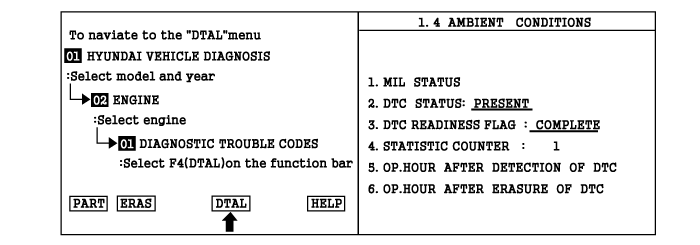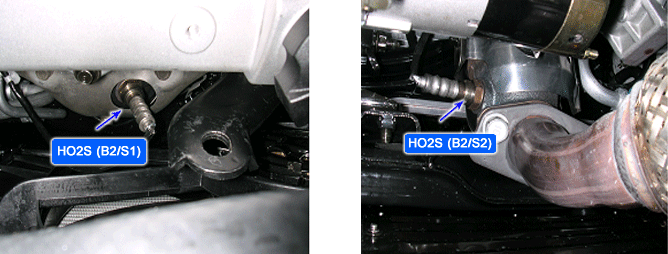Read "DTC Status" parameter.


The ECM uses dual oxygen sensors to monitor the efficiency of the manifold catalytic converter (warm-up catalytic converter). By monitoring the oxygen storage capacity of a catalyst, its efficiency can be indirectly calculated. The upstream (front) HO2S is used to detect the amount of oxygen in the exhaust gas before it enters the catalytic converter. A low voltage indicates high oxygen contents (lean air mixture). A high voltage indicates low oxygen contents (rich air mixture). When the catalyst efficiency drops, no chemical reaction takes place. This means the concentration of oxygen will be the same at the rear as it is at the front. The output voltage of the rear HO2S copies the voltage of the front HO2S.To monitor the system, the lean-to-rich switches of the front HO2S to the rear HO2S is counted. The ratio of rear switches to front switches is used to determine whether the catalyst is operating properly. An effective catalyst will have fewer rear switches than front switches, that is, a ratio closer to zero.
The ECM calculates oscillation size of rear HO2S signal which represents catalyst conversion properties. This oscillation size will determine if catalyst conversion is low due to aging or poisoning from leaded fuel or misfiring. The ECM sets P0430 if the average of calculated oscillation size of rear HO2S signal during predetermined duration is higher than the predetermined threshold.
ITEM | DETECTING CONDITION | POSSIBLE CAUSE |
DTC Strategy | ● Comparison of the signal ratio of upstream and downstream O2 sensor in a load and speed range | ● Exhaust gas leaks ● Rear HO2S malfunction ● Three way catalyst converter malfunction |
Enable Conditions | ● 400(752℉)〈 Catalyst model temperature 〈600℃(1112℉) ● Coolant temperature 〉70℃(158) ● Lambda control within limit ● 800rpm〈 Engine speed 〈 2500rpm ● Air mass flow 〈250 mg/stk ● No misfire is detected ● Not transient condition | |
Threshold Value | ● Averaged malfunction index 〉 0.7 | |
Diagnostic Time | ● 120 lambda controller cycles |
If any codes relating to injectors, HO2S, ECT(Engine Coolant Temperature)Sensor, Throttle Position sensor or Mass Air Flow Sensor are stored, do ALL REPAIRS associated with those codes before proceeding with this troubleshooting tree.
Connect scan tool and select "Diagnostic Trouble Codes(DTCs)" mode.
Press F4(DTAL) to select DTC information from the DTCs menu.
Confirm that "DTC Readiness Flag" indicates "Complete". If not, drive the vehicle within conditions noted in the freeze frame data or enable conditions
Read "DTC Status" parameter.

Is parameter displayed "History(Not Present) fault"?
History (Not Present) fault : DTC occurred but has been cleared.
Present fault : DTC is occurring at present time.

▶ Fault is intermittent caused by poor contact in the sensor's and/or ECM's connector or was repaired and ECM memory was not cleared. Thoroughly check connectors for loose or poor connections, bending, corrosion, contamination, deterioration, or damage. Repair or replace as necessary and go to "Verification of Vehicle Repair" procedure.

▶ Go to next step as below.
Visually/physically inspect the rear HO2S for the following conditions:
Exhaust system between HO2S and Three way catalyst for air leakage
Damage, and for loose or missing hardware.
Was a problem found in any of the above areas?

▶ Repair as necessary and go to "Verification of Vehicle Repair" procedure.

▶ Go to "Rear HO2S Inspection " procedure.
Visually/physically inspect the rear HO2S for the following conditions:
Ensure that the HO2S is securely installed.(Pigtail and wiring harness not making contact with the exhaust pipe)
Check for corrosion on terminals.
Check for terminal tension. ( at the HO2S and at the ECM)
Any road damage.
Was a problem found in any of the above areas?

▶ Repair as necessary and go to "Verification of Vehicle Repair" procedure

▶ Go to "TWC Inspection " procedure
Visually/physically inspect the three-way catalyst(TWC) converter for the following damage:
Severe discoloration caused by excessive temperature.
Dents and holes.
Internal rattle caused by a damaged catalyst.
Also, ensure that the TWC is a proper original equipment manufacturer part.
Was a problem found?

▶ Replace TWC and go to "Verification of Vehicle Repair" procedure.

▶ Check for poor connection between ECM and component: backed out terminal, improper mating, broken locks or poor terminal to wire connection. Repair as necessary and go to "Verification of Vehicle Repair" procedure.
After a repair, it is essential to verify that the fault has been corrected.
Connect scan tool and select "Diagnostic Trouble Codes(DTCs)" mode.
Press F4(DTAL) and confirm that "DTC Readiness Flag" indicates "Complete". If not, drive the vehicle within conditions noted in the freeze frame data or enable conditions.
Read "DTC Status" parameter.
Is parameter displayed "History(Not Present) fault"?

▶ System performing to specification at this time. Clear the DTC

▶ Go to the applicable troubleshooting procedure.